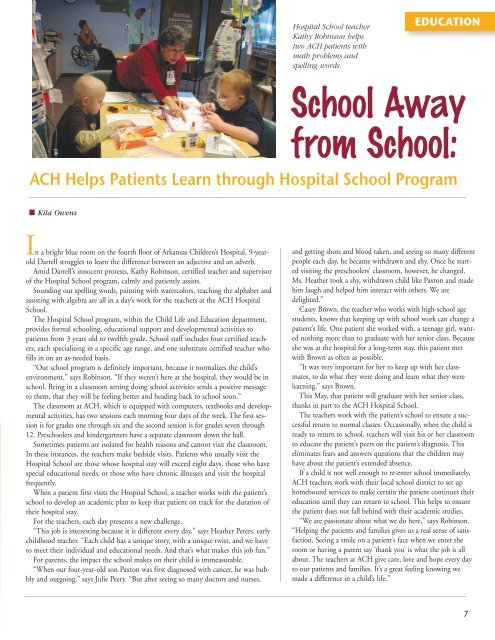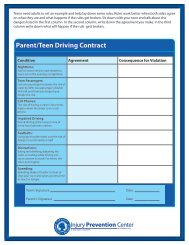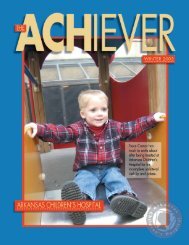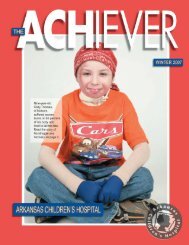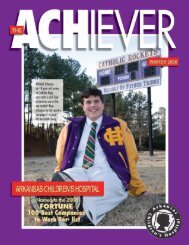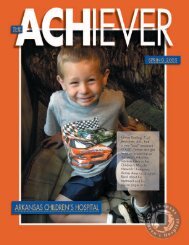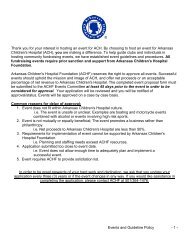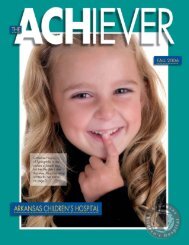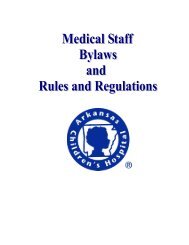Winter 2009 - Arkansas Children's Hospital
Winter 2009 - Arkansas Children's Hospital
Winter 2009 - Arkansas Children's Hospital
- No tags were found...
You also want an ePaper? Increase the reach of your titles
YUMPU automatically turns print PDFs into web optimized ePapers that Google loves.
<strong>Hospital</strong> School teacherKathy Robinson helpstwo ACH patients withmath problems andspelling words.EDUCATIONSchool Awayfrom School:ACH Helps Patients Learn through <strong>Hospital</strong> School Program■ Kila OwensIn a bright blue room on the fourth floor of <strong>Arkansas</strong> Children’s <strong>Hospital</strong>, 9-yearoldDarrell struggles to learn the difference between an adjective and an adverb.Amid Darrell’s innocent protests, Kathy Robinson, certified teacher and supervisorof the <strong>Hospital</strong> School program, calmly and patiently assists.Sounding out spelling words, painting with watercolors, teaching the alphabet andassisting with algebra are all in a day’s work for the teachers at the ACH <strong>Hospital</strong>School.The <strong>Hospital</strong> School program, within the Child Life and Education department,provides formal schooling, educational support and developmental activities topatients from 3 years old to twelfth grade. School staff includes four certified teachers,each specializing in a specific age range, and one substitute certified teacher whofills in on an as-needed basis.“Our school program is definitely important, because it normalizes the child’senvironment,” says Robinson. “If they weren’t here at the hospital, they would be inschool. Being in a classroom setting doing school activities sends a positive messageto them, that they will be feeling better and heading back to school soon.”The classroom at ACH, which is equipped with computers, textbooks and developmentalactivities, has two sessions each morning four days of the week. The first sessionis for grades one through six and the second session is for grades seven through12. Preschoolers and kindergartners have a separate classroom down the hall.Sometimes patients are isolated for health reasons and cannot visit the classroom.In these instances, the teachers make bedside visits. Patients who usually visit the<strong>Hospital</strong> School are those whose hospital stay will exceed eight days, those who havespecial educational needs, or those who have chronic illnesses and visit the hospitalfrequently.When a patient first visits the <strong>Hospital</strong> School, a teacher works with the patient’sschool to develop an academic plan to keep that patient on track for the duration oftheir hospital stay.For the teachers, each day presents a new challenge.“This job is interesting because it is different every day,” says Heather Peters, earlychildhood teacher. “Each child has a unique story, with a unique twist, and we haveto meet their individual and educational needs. And that’s what makes this job fun.”For parents, the impact the school makes on their child is immeasurable.“When our four-year-old son Paxton was first diagnosed with cancer, he was bubblyand outgoing,” says Julie Peery. “But after seeing so many doctors and nurses,and getting shots and blood taken, and seeing so many differentpeople each day, he became withdrawn and shy. Once he startedvisiting the preschoolers’ classroom, however, he changed.Ms. Heather took a shy, withdrawn child like Paxton and madehim laugh and helped him interact with others. We aredelighted.”Casey Brown, the teacher who works with high-school agestudents, knows that keeping up with school work can change apatient’s life. One patient she worked with, a teenage girl, wantednothing more than to graduate with her senior class. Becauseshe was at the hospital for a long-term stay, this patient metwith Brown as often as possible.“It was very important for her to keep up with her classmates,to do what they were doing and learn what they werelearning,” says Brown.This May, that patient will graduate with her senior class,thanks in part to the ACH <strong>Hospital</strong> School.The teachers work with the patient’s school to ensure a successfulreturn to normal classes. Occasionally, when the child isready to return to school, teachers will visit his or her classroomto educate the patient’s peers on the patient’s diagnosis. Thiseliminates fears and answers questions that the children mayhave about the patient’s extended absence.If a child is not well enough to re-enter school immediately,ACH teachers work with their local school district to set uphomebound services to make certain the patient continues theireducation until they can return to school. This helps to ensurethe patient does not fall behind with their academic studies.“We are passionate about what we do here,” says Robinson.“Helping the patients and families gives us a real sense of satisfaction.Seeing a smile on a patient’s face when we enter theroom or having a parent say ‘thank you’ is what the job is allabout. The teachers at ACH give care, love and hope every dayto our patients and families. It’s a great feeling knowing wemade a difference in a child’s life.”7


